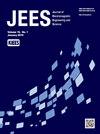带搜索跟踪功能的2 - 18ghz ELINT系统前端接收机和矩阵设计
IF 1.7
3区 工程技术
Q3 ENGINEERING, ELECTRICAL & ELECTRONIC
Journal of electromagnetic engineering and science
Pub Date : 2023-01-31
DOI:10.26866/jees.2023.1.r.142
引用次数: 0
摘要
在本文中,我们描述了2−18GHz的前端接收机和矩阵模块的设计和制造,该接收机具有高增益、良好的相位匹配特性和可靠性;这是通过使用裸型单片微波集成电路(MMIC)器件应用芯片和布线工艺来实现的。为了补偿多个子模块之间的不匹配,设计了适合子带频率特性的前端模块、矩阵模块和内置测试模块,并将其应用于直接接收机。矩阵盒使用高通滤波器来去除不需要的低频,并使用4路分频器来分配单个输入BIT信号。宽带接收器模块有两条路径:相位路径和幅度路径。相位和振幅匹配的不同长度的射频半刚性电缆用于连接矩阵接收器的内部子模块。主RF线是介电衬底RT/Duroid 5880,相对介电常数为2.2,介电厚度为0.127mm。前端接收器和矩阵盒的尺寸分别为137mm×120mm×31mm和250mm×238mm×138mm。在宽带频率接收器模块中,中频(频率2−6 GHz)的增益为22.99 dB,回波损耗约为14.76 dB。在高频段(频率6−18 GHz),增益为23.25 dB,回波损耗约为11.63 dB。2–6 GHz的通道之间的相位匹配峰值为±3.30°,6–18 GHz的通道间的相位匹配峰值为±8.24°。本文章由计算机程序翻译,如有差异,请以英文原文为准。
Design of Front-End Receiver and Matrix for 2–18 GHz with a Searching and Tracking Function for an ELINT System
In this paper, we describe the design and fabrication of a front-end receiver and matrix modules for 2−18 GHz with high gain, good phase matching characteristics, and reliability; this was accomplished by applying a chip-and-wire process using a bare-type monolithic microwave integrated circuit (MMIC) device. To compensate for the mismatch among many sub-modules, a front-end module, matrix module, and built-in test module suitable for sub-band frequency characteristics were designed and applied to the direct receiver. The matrix box used a high-pass filter to remove unwanted low frequencies and a 4-way divider to distribute single input BIT signals. The broadband receiver module had two paths: a phase path and an amplitude path. Phase- and amplitude-matched radio frequency semi-rigid cables of different lengths were used to connect to the internal sub-modules of the matrix receiver. The main RF line was a dielectric substrate, RT/Duroid 5880, with a relative dielectric constant of 2.2 and a dielectric thickness of 0.127 mm. The sizes of the front-end receiver and matrix box were 137 mm × 120 mm × 31 mm and 250 mm × 238 mm × 138 mm, respectively. In the wideband frequency receiver module, the gain was 22.99 dB at mid-band (frequency 2−6 GHz) with a return loss of about 14.76 dB. Th e gain was 23.25 dB at a high band (frequency 6−18 GHz), having a return loss of about 11.63 dB. The peak values of phase matching among the channels for 2–6 GHz were ±3.30°, and the peak values of phase matching among the channels for 6–18 GHz were ±8.24°.
求助全文
通过发布文献求助,成功后即可免费获取论文全文。
去求助
来源期刊

Journal of electromagnetic engineering and science
ENGINEERING, ELECTRICAL & ELECTRONIC-
CiteScore
2.90
自引率
17.40%
发文量
82
审稿时长
10 weeks
期刊介绍:
The Journal of Electromagnetic Engineering and Science (JEES) is an official English-language journal of the Korean Institute of Electromagnetic and Science (KIEES). This journal was launched in 2001 and has been published quarterly since 2003. It is currently registered with the National Research Foundation of Korea and also indexed in Scopus, CrossRef and EBSCO, DOI/Crossref, Google Scholar and Web of Science Core Collection as Emerging Sources Citation Index(ESCI) Journal. The objective of JEES is to publish academic as well as industrial research results and discoveries in electromagnetic engineering and science. The particular scope of the journal includes electromagnetic field theory and its applications: High frequency components, circuits, and systems, Antennas, smart phones, and radars, Electromagnetic wave environments, Relevant industrial developments.
 求助内容:
求助内容: 应助结果提醒方式:
应助结果提醒方式:


